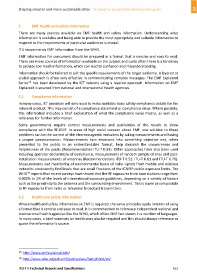Page 625 - Shaping smarter and more sustainable cities - Striving for sustainable development goals
P. 625
5 EMF health and safety information
There are many sources available on EMF health and safety information. Understanding what
information is available and being able to provide the most appropriate and suitable information to
respond to the requirements of particular audiences is crucial.
ITU recommends EMF information from the WHO.
EMF information for consumers should be prepared in a format that is concise and easy to read.
There are many sources of information available on the subject and quite often there is a tendency
to provide too much information, which can lead to confusion and misunderstanding.
Information should be tailored to suit the specific requirements of the target audience. A layered or
scaled approach is often very effective in communicating complex messages. The EMF Explained
15
Series has been developed by the ICT industry using a layered approach. Information on EMF
Explained is sourced from national and international health agencies.
5.1 Compliance information
In many cases, ICT providers will only need to make available basic safety compliance details for the
relevant product. This may consist of a compliance statement or compliance value. Where possible,
this information includes a brief explanation of what the compliance value means, as well as a
reference for further information.
Some governments require control measurements and publication of the results to show
compliance with the RF‐EMF. In areas of high social concern about EMF, one solution to these
problems can be the control of the electromagnetic emissions by taking measurements and having
a proper communication. Measurements turn emissions into something objective and, when
presented to the public in an understandable format, help diminish the unawareness and
helplessness of the public (Recommendation ITU‐T K.83). Other approaches have also been used
including operator declarations of compliance, measurements of random sample of sites and post‐
installation measurements of antennas (Recommendations ITU‐T K.52; ITU‐T K.61 and ITU‐T K.70).
Measurements and monitoring of environmental levels of radio signals from mobile and wireless
networks consistently find levels that are small fractions of the ICNIRP public exposure limits. The
16
WHO reports that recent surveys have shown that the RF exposures from base stations range from
0.002% to 2% of the levels of international exposure guidelines, depending on a variety of factors
such as the proximity to the antenna and the surrounding environment. This is lower or comparable
to RF exposures from radio or television broadcast transmitters.
5.2 Health and safety information
Where health and safety information on EMF is required, the same principles apply in terms of using
a format that is concise and easy to read. It is recommended to reference independent national and
international health agencies like the WHO, which offers EMF fact sheets in a number of languages.
In many cases, a brief summary on health may also be required and this should always reference or
quote the information’s source.
____________________
15 http://www.emfexplained.info/
16 http://www.who.int/peh‐emf/publications/facts/fs304/en/
ITU‐T's Technical Reports and Specifications 615

